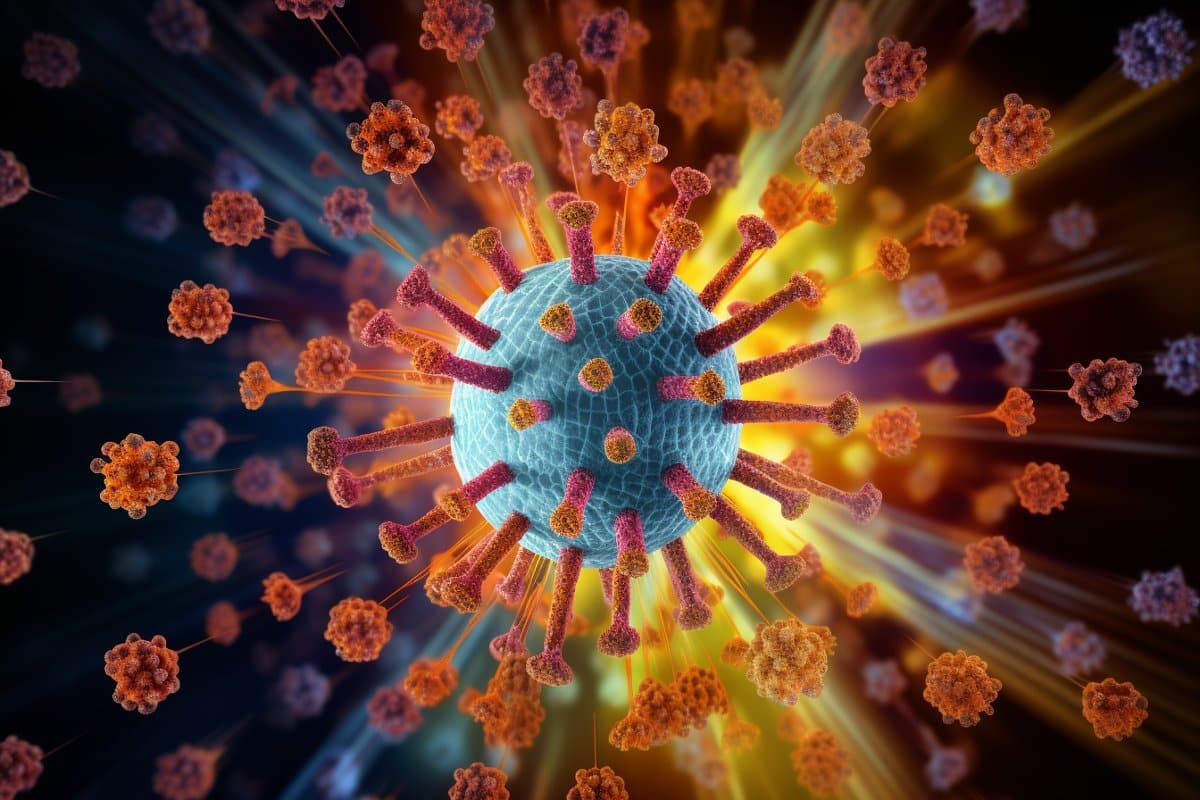Summary: New research offers compelling evidence that many excess mortality cases during the pandemic were in fact due to COVID-19, countering claims attributing these deaths to vaccines or lockdowns.
The study used novel statistical methods to analyze excess deaths from natural causes in US counties, revealing a significant undercount of COVID-19 fatalities. This analysis found that excess deaths paralleled reported COVID-19 deaths temporally and geographically, especially in nonmetropolitan areas, highlighting the pandemic’s true impact and the role of public health interventions.
The findings advocate for standardized death reporting and underscore the importance of accurate death attribution for pandemic response and future health policies.
Key Facts:
- The study estimated 1.2 million excess natural-cause deaths during the first 30 months of the pandemic, with about 163,000 not listed as COVID-19 on death certificates.
- Temporal and geographical analysis showed that non-COVID excess deaths and reported COVID-19 deaths were largest in nonmetropolitan counties, the West, and the South.
- The research refutes claims that excess mortality was due to vaccination or lockdown policies, highlighting instead the need for standardized death certification.
Source: Boston University
A new study provides the most compelling data yet to suggest that excess mortality rates from chronic illnesses and other natural causes were actually driven by COVID-19 infections, disproving high-profile claims that have attributed these deaths to other factors such as COVID vaccinations and shelter-in-place policies.
Nearly 1,170,000 people have died from COVID-19 in the United States, according to official federal counts, but multiple excess mortality studies suggest that these totals are vastly undercounted.
While excess mortality provides an estimation of deaths that likely would not have occurred under normal, non-pandemic conditions, there is still little evidence into whether the SARS-CoV-2 virus contributed to these additional deaths, or whether these deaths were caused by other factors such as health care disruptions or socioeconomic challenges.
Now, a new study led by Boston University School of Public Health (BUSPH) and the University of Pennsylvania (UPenn) provides the first concrete data showing that many of these excess deaths were indeed uncounted COVID-19 deaths.
Published in the journal PNAS, the study compared reported COVID-19 deaths to excess deaths due to non-COVID natural causes, such as diseases and chronic illnesses, and found that increases in non-COVID excess deaths occurred at the same time or in the month prior to increases in reported COVID-19 deaths in most US counties.
Focusing on excess deaths by natural causes rather than all-cause excess death estimates provides a more accurate understanding of the true number of deaths attributable to COVID-19, as it eliminates external causes for mortality, such as intentional or unintentional injuries, for which COVID-19 would not be a contributing factor.
“Our findings show that many COVID-19 deaths went uncounted during the pandemic. Surprisingly, these undercounts persisted well beyond the initial phase of the pandemic,” says study corresponding author Dr. Andrew Stokes, associate professor of global health at BUSPH, who has led numerous studies analyzing excess mortality patterns and drivers during the pandemic.
The temporal correlation between reported COVID-19 deaths and excess deaths reported to non-COVID-19 natural causes offers insight into the causes of these deaths, he says.
“We observed peaks in non-COVID-19 excess deaths in the same or prior month as COVID-19 deaths, a pattern consistent with these being unrecognized COVID-19 deaths that were missed due to low community awareness and a lack of COVID-19 testing.”
If the primary explanation for these deaths were health care interruptions and delays in care, the non-COVID excess deaths would likely occur after a peak in reported COVID-19 deaths and subsequent interruptions in care, says study lead author Eugenio Paglino, a Ph.D. student studying demography and sociology at UPenn.
“However, this pattern was not observed nationally or in any of the geographic subregions we assessed,” Paglino says.
Importantly, these findings also disprove political assertions or public beliefs that have attributed mortality during the pandemic to COVID-19 vaccinations or shelter-in-place policies.
“This work is important because our ability to detect and correctly assign deaths during an epidemic goes to the heart of our understanding of the disease and how we organize our response,” says Dr. Nahid Bhadelia, founding director of the Boston University Center for Emerging Infectious Diseases Policy and Research.
For the study, Dr. Stokes, Dr. Paglino, and colleagues utilized novel statistical methods to analyze monthly data on natural-cause deaths and reported COVID-19 deaths for 3,127 counties over the first 30 months of the pandemic, from March 2020 to August 2022.
They estimated that 1.2 million excess natural-cause deaths occurred in US counties during this time period, and found that roughly 163,000 of these deaths did not have COVID-19 listed at all on the death certificates.
Analyzing both temporal and geographical patterns of these deaths, the researchers found that the gap between these non-COVID excess deaths and reported COVID-19 deaths was largest in nonmetropolitan counties, the West, and the South—and that the second year of the pandemic saw almost as many non-COVID excess deaths in the second year of the pandemic as in the first year, contrary to previous research.
Meanwhile, metropolitan areas in New England and the Mid-Atlantic states were the only areas to report more COVID-19 deaths than non-COVID excess deaths.
Many of these geographical differences in death patterns are likely explained by differences in state policies, COVID death protocols, or political biases by local officials that influenced COVID policies. In rural areas, for example, COVID-19 testing was more limited, and political biases or stigma around COVID may have affected whether COVID-19 was listed on a death certificate.
Conversely, reported COVID-19 deaths may have exceeded non-COVID excess deaths due to successful mitigation policies that encouraged physical distancing and masking, and likely lowered cases of other respiratory diseases. Certain state protocols, such as in Massachusetts, also enabled death investigators to list COVID-19 as an official cause of death within 60 days of a diagnosis (until March 2022), rather than the 30-day limit in other states.
“Geographic variation in the quality of cause of death reporting not only adversely affected pandemic response in areas where COVID-19 deaths were underreported, but it also reduced the accuracy of our national surveillance data and modeling,” says study co-author Katherine Hempstead, senior policy adviser at the Robert Wood Johnson Foundation.
“Standardizing and improving death investigation and certification should be a public health priority.”
The researchers hope this new data will encourage future analyses using hospitalizations and other local data to continue to parse uncounted COVID-19 deaths from excess natural-cause as well as external deaths.
“This study documents the deadliness of COVID-19 and the effectiveness of public health interventions,” said Kristin Urquiza, who cofounded Marked By COVID, the justice and remembrance movement led by COVID grievers, after losing her father to COVID. “The least we can do to honor those who died is to accurately account for what happened.”
The study was also coauthored by researchers at BUSPH, UPenn, University of Washington School of Public Health, the University of Minnesota, RTI International and the University of California, San Francisco.
About this mortality and COVID-19 research news
Author: Andrew Stokes
Source: Boston University
Contact: Andrew Stokes – Boston University
Image: The image is credited to Neuroscience News
Original Research: Open access.
“Excess natural-cause mortality in US counties and its association with reported COVID-19 deaths” by Andrew Stokes et al. PNAS
Abstract
Excess natural-cause mortality in US counties and its association with reported COVID-19 deaths
Official COVID-19 mortality statistics have not fully captured deaths attributable to SARS-CoV-2 infection in the United States. While some excess deaths were likely related to pandemic health care interruptions and socioeconomic disruptions, temporal correlations between reported COVID-19 deaths and excess deaths reported to non-COVID-19 natural causes suggest that many of those excess deaths were unrecognized COVID-19 deaths.
Efforts to target resources during public health emergencies should consider geographic variation in the quality of mortality surveillance data. Incomplete or delayed cause-of-death reporting may obscure impacts in some areas, leading to ineffective and inequitable responses and evaluations of the pandemic’s effects.
To address this, future pandemic preparedness and response efforts should include activities to strengthen the death investigation system.







